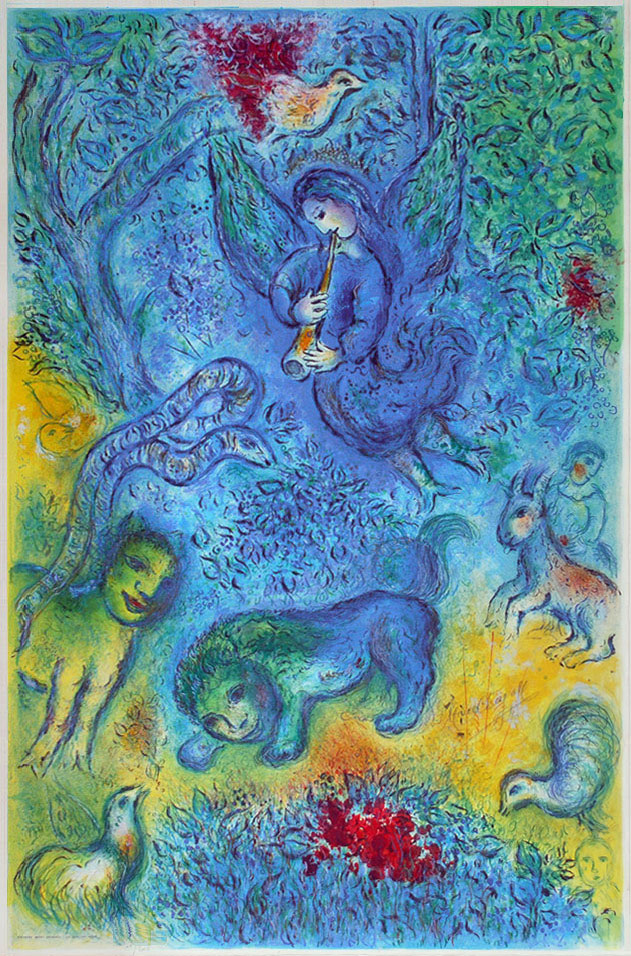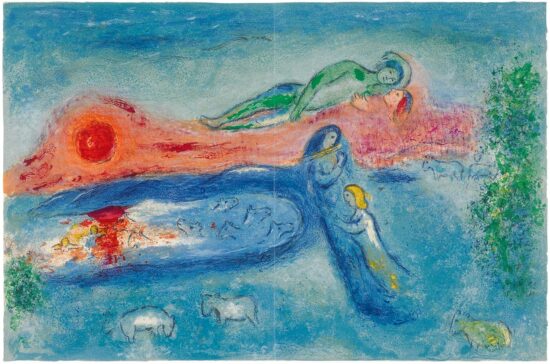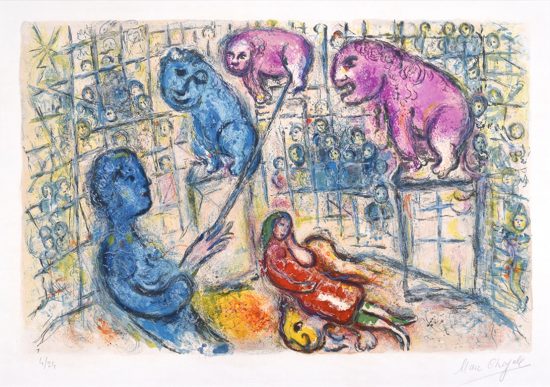Marc Chagall: Elementary/Middle
- Marc Chagall
LESSON PLAN: MARC CHAGALL
Overview: By studying the art and style of Marc Chagall, students will create a fanciful piece of art representing themselves and their surroundings and illustrating Chagall’s quote “Great art picks up where nature ends.”
Age Group: Grades 3 – 8
State Standards:
Visual Arts
Standard 1: Students perceive and respond to works of art, objects in nature, events, and the environment. They also use the vocabulary of the visual arts to express their observations.
Standard 2: Students apply artistic processes and skills, using a variety of media to communicate meaning and intent in original works of art.
Standard 3: Students analyze the role and development of the visual arts in past and present cultures throughout the world, noting human diversity as it relates to the visual arts and artists.
Length of Lesson:
One 90 minute lesson
Objectives:
Students will be able to:
- Define the following terms: color, line, shape
- Analyze a work of art in terms of the artist’s use of these elements
- Relate cultural influences and historical elements to the artwork that they view
- Create fanciful, colorful drawings in the style of Marc Chagall
Materials:
- Examples of artwork by Marc Chagall
- Paper
- Black pencil/marker/pastel
- Colored pencils/markers/pastels
Lesson:
- Introduce students to the art and style of Chagall, engaging them in discussion about his work and use of intense color to create a dreamlike effect.
- CHAGALL
- Born in Liozna near Vitebsk (then a part of the Russian Empire) to a family of Hasidic Jews. In 1906, he moved to St. Petersburg to study art. By 1910, Chagall had set his sights on Paris and moved to the cultural hub to pursue a career as a professional artist.
- Through the development of his whimsical, romantic style, Chagall achieved greatness. The public became enchanted with Chagall’s fairy-tale touches, fanciful motifs, and colorful, ethereal imagery.
- During World War II when the Nazi party took power, Chagall sought refuge in America, accepting the invitation of the Museum of Modern Art to live in New York’s lower East Side. Adjusting to life in America was not easy, as Chagall had difficulty communicating in English.
- In 1948, Chagall had settled permanently in France and continued to create beautiful and inspired works. He lived a prosperous and full life, ultimately passing away at the age of 98 from a heart attack.
- INFLUENCES
- Hasidism – founded by Baal Schem Tov, played a big part in his artwork. Hasidism won over a large segment of the Jewish population of Eastern Europe in late 1800s, and Chagall was raised in the Hasidic tradition. This spirit of Jewish mysticism is apparent in Chagall’s work throughout his lifetime.
- Paul Gauguin
- Chagall never forgot his home village of Vitebsk, incorporating Russian folklore and childhood memories into his artwork. However, he also embraced the culturally rich worlds of St. Petersburg and, more importantly, of Paris, consistently incorporating elements from these cities into his work.
- Chagall’s first wife, Bella Rosenfeld compositions, a striking beauty with a large white collar framing her lovely face.
- ARTISTIC STYLE
- Chagall was both a brilliant colorist and a gifted storyteller, as romantic narratives come to life before one’s eyes. His poetic depictions and childlike imagery allow the viewer to escape the realm of the real and enter the world of the imagined.
- SYMBOLS/SUBJECTS:
- Couples
- Animals
- Clocks
- The Eiffel Tower
- Flowers (bouquets)
- Roosters
- Fiddlers
- Fish
- Candlesticks
- Windows
- Homes/Villages
- Scenes of the Circus
- CHAGALL
- Show the following works:
- The Clock
- Song of Songs
- Plate 6 from Arabian Nights
- The Magic Flute
- Instruct students to write “Great art picks up where nature ends” around the perimeter of the papers, or just write it on the board for them to see.
- Using a black pencil, marker, or pastel (pastels work best), have students draw a house, then turn their papers and draw themselves holding something they like; turn the papers again and draw trees/flowers; have them include a sun or moon with a face.
- Once their paper is filled, they may render their illustrations with oil pastels, taking care to use lots of intense colors like Chagall.
| IMAGE |
ARTIST |
TITLE |
|
|
Marc Chagall | The Clock |
|
|
Marc Chagall | Song of Songs |
 |
Marc Chagall | Arabian Nights |
|
|
Marc Chagall | The Magic Flute |






